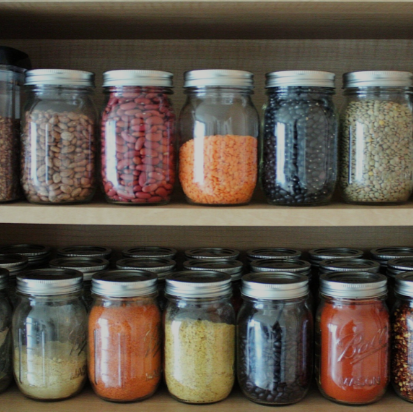Food Essentials
A few days without food and you will be feeling the effects. A few weeks, and you will not be around anymore. Food storage is imperative for a survival kit because it is hard to obtain after a disaster. While hunters and anglers bring great skills to the table in this area, there may not always be time or opportunity to look for food. You want to start with a three-day supply (at the very least) and then work your way up from there. Food storage items we use and suggest:
- Back Stock Your Pantry: Stocking all the food in your pantry with longer shelf lives can be an easy way to chip away at food storage.
- Canned Foods: Some canned foods are better than others.
- Freeze Dried Food Storage
- Manual Can Opener
Short-Term Survival Food List
Short-term disasters are extremely common, and you’ll need to be prepared to get through them.
Luckily, they are short (by definition) so you don’t need a ton of food on hand to be able to survive them. Here are the bare essentials:
- Water – More important than food (you can’t survive long without water), you’ll need 1-2 gallons per person for each day. Our handy-dandy water calculator can do the math for you and show you the easiest ways to store water depending on how much you need.
- Canned Food – Extremely easy to store and cheap, this is always our go-to suggestion for starting out and it will always be part of your food storage plan.
- Energy Bars or Granola Bars
- Peanut Butter and Other Nut Butter
- Crackers, Chips, and Other Pantry Snacks
- Dried Fruits – dry using a dehydrator or freeze dryer.
- Nuts
- Powdered Milk – versatile and high-density protein is easy to store. See our the best-reviewed powdered milk for your specific application.
- Oatmeal or Cereal
- Jams and Jellies
- Baby Formula – If you have a little one, plan ahead. In a pinch, you can make your own baby formula.
- Pet Food – It’s easy enough to stock a little extra food for your pets. Many pet foods have long shelf lives.
It’s important to rotate these through regularly, though. You don’t want a disaster to strike just to find most of your short-term food storage expired. All of these are easy enough to mix into regular everyday meals and snacks, and you can restock them at your local grocery store.
Long-Term Survival Food List
Long-term disasters are less common but can have an extreme impact.
Here are the best foods for long-term food storage:
- Water – Again, water is paramount! Get your water situation figured out quickly: water storage calculator.
- Canned Food – Great for both short and long-term storage, but you’ll still want to rotate through them regularly.
- Beans, Lentils, and Rice – These are staples of food storage with extreme shelf-life when stored properly.
- Energy Bars or Granola Bars
- Peanut Butter and Other Nut Butter – Don’t sleep on the benefits of peanut butter.
- Survival Bread – The term ‘survival bread’ covers a wide range of long-shelf-life bread and crackers.
- Powdered Milk – shelf-stable and packed with nutrients, stockpile the best powdered milk.
- Olive Oil, Vegetable Oil, & Lard – The most calorie-dense food you can find can also be a cooking aide
- Canned Preserves – Self-canned and pickled foods keep a great shelf life in your pantry.
- Dehydrated Fruits and Vegetables – Extend the life of your greens with a dehydrator, these make up the majority of the best foods to dehydrate.
- Honey – One of those foods that can last forever- obviously great for long-term storage!
- Freeze-Dried Meals – Emergency food storage is made easy with the best emergency food suppliers. They also make specific freeze-dried foods including:
- Freeze-Dried Meat – Space-saving, tastes great, and has an extreme shelf-life.
- Freeze-Dried Fruit – Vitamins, antioxidants, and fiber with a long shelf-life.
- Freeze-Dried Vegetables – Essential vitamins and minerals with a long shelf-life.
- Condiments – There are a wide variety of shelf-stable condiments that can make survival food much more palatable.
It’s important to rotate these through regularly, though. You don’t want a disaster to strike just to find most of your short-term food storage expired. All of these are easy enough to mix into regular everyday meals and snacks, and you can restock them at your local grocery store.
Storing Long-Term Survival Food
Where and how you store your survival food is just as important as the shelf-life of the food itself.
You’ll want to keep the food in a dark cool place where rodents and bugs cannot easily get to it.
One of the best storage methods for all survival food is to use food storage buckets. Pack the food into mylar bags and seal them air-tight with oxygen absorbers before loading them into the bucket. This will protect all of your hard work and preserve the shelf life of your emergency food.
Most people prefer to store on storage racks (make sure they can support the weight) and use a FIFO system to rotate their food storage. FIFO stands for “First in, First out” and means that you will use the oldest foods first as you replenish with newer food.
If you design your storage with FIFO in mind, it will be easy to stick to and you’ll have less food spoilage to worry about.
Best Ways to Preserve Food
There are many ways to preserve food and people have been doing it for thousands of years. We’ve come a long way from those thousand-year-old techniques though, and we have the technology to make food preservation easy.
Here are the best ways to preserve food:
- Canning – an entire lifestyle and hobby can pickle and preserve just about anything. Our reviews of canning equipment can help get you started quickly.
- Dehydrating – with a small dehydrator, you can extend the life of meat, fruit, and veggies.
- Freeze-Drying – freeze dryers are not cheap, but if you’re serious about shelf-life freeze drying is head and shoulders above other preservation methods. This is why emergency food companies specialize in freeze-dried meals.
- Vacuum Sealing – you can vacuum seal any food to extend how long it lasts, even if it is just an everyday meal. Vacuum sealing is usually paired with another method, like dehydrating, to even further the shelf-life.
- Freezing – tossing food in your freezer will help preserve it, but you need power to keep it frozen. Most disasters cause power outages so you’ll need to plan ahead with alternate power sources if this is your preservation method.
- Store it in its Packaging – with canned foods and a few others, you can just put them on the shelf.
- Food-Grade Buckets – loading food-grade buckets with dry rice or beans can be a quick prepping project.
- Mylar Bags with Oxygen Absorbers – even better, seal the food in a mylar bag with a matching oxygen absorber and then place it in the food-grade bucket for an air-tight redundant preservation and storage method.
Bug-Out Survival Food List
Sometimes you need to evacuate, or as we like to call it: bug out. Food and water can weigh a lot so that factors into what you can take with you.
Here are the best bug out foods:
- Water – Yes, we know it’s not food but it is important. We can’t stress enough how important water is for your preparedness. It weighs a lot (8.34 pounds per gallon) so we have a whole write-up dedicated to bug-out water.
- Survival Food Bars – You could go with emergency ration bars, but there are better options: emergency food bars.
- MREs (Meal, Ready to Eat): The military go-to is high-calorie food and a cooking system all-in-one.
- Tuna Pouches – Skip the cans and go for the lighter-weight pouches.
- Beef Jerky – Widely available and a great protein source on the go.
- Energy Bars – not quite the calories as survival food bars, but a good cheap option.
- Freeze-Dried Mobile Packs – Some of the best emergency food suppliers offer portable options: notably Mountain House and Nutrient Survival (our upgrade pick).
- Nuts – packed with protein and compact, these can give you a boost on the move.
Survival Food Checklist
A perfect survival food list doesn’t exist- what is right for you depends on your situation, capabilities, and risk tolerance. That said, we have as close to perfect of a starting point for you: our comprehensive survival food checklist.
Our checklist is available as both a pdf download and as a Google Sheet/Excel file where you can check off items yourself, and even add and subtract items from the checklist.
Source: https://trueprepper.com/survival-food-list/
Terms of Use:The information presented on the network is intended to expand personal knowledge and provide general understanding in a variety of fields to help you be active your Creative freedom and nurturing your health. The information presented here does not pretend to be and is not a substitute for medical instructions. Everything presented on the network is the personal opinion of the writers and any decision regarding your action or health choice is your sole responsibility. with regards For complete inner freedom.
Outhematrix (out the matrix) Network management.







